My New Way of Taking Book Notes
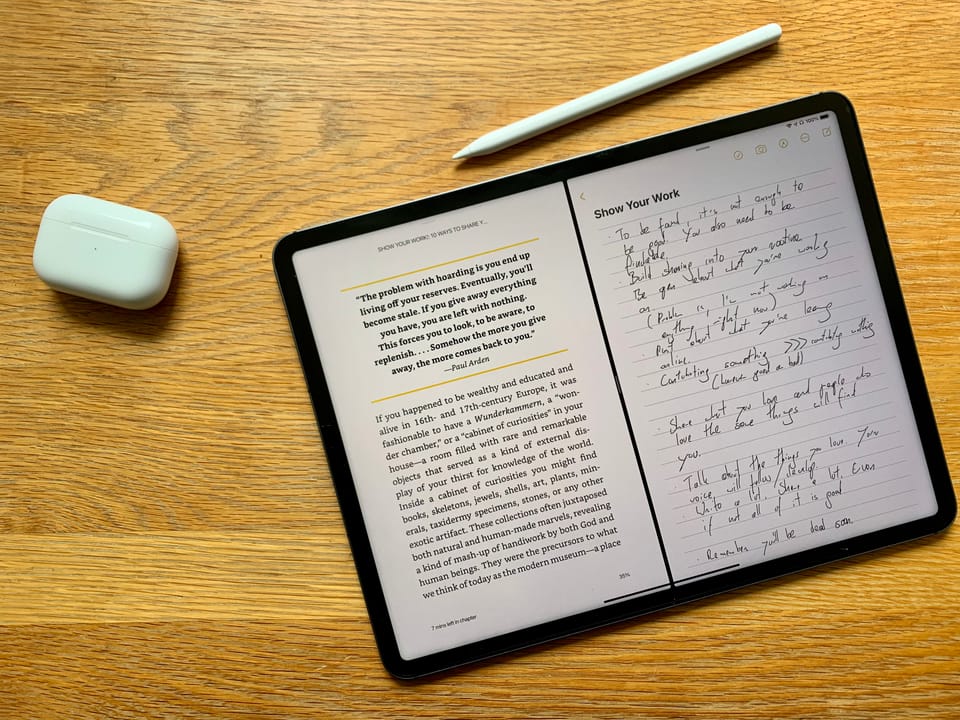
You finish the book, feel good with yourself for gaining new knowledge, and mark it as read in Goodreads with a sense of triumph. But then some time passes, not even a lot, and you find it hard recalling anything about that book besides, maybe, the gist of it. Sound familiar?
Whoa! – it's been a while. I'm Chris and I'm still working on my about page. This is METAGAME – a blog? a newsletter? a home page on the internet! – or simply a place where I irregularly write about photography, tech, and my workflows. Today we're going to tackle that last one.
Oh, almost forgot. Moved this page to a proper domain – metagame.hk. Things just got serious!
Recently, I find myself reading more, and reading more of quality material. That includes books (mostly non-fiction) on Kindle and articles saved into my Readwise Reader.
I’m not reading only for pure enjoyment — I do it to extract knowledge, learn a new skill, and/or give my mind a new idea to chew on. It’s productive reading — and I want its benefits — insights, skills, knowledge — to last longer than what my short-term memory typically allows for.
That makes note-taking a critical part of the reading process. Going through books, especially non-fiction, with a pen(cil) in hand helps immensely with information retention.
I can write a lot about note-taking app journey, jumping from one app to another. Evernote (my first note-taking love), Obsidian, Bear, OneNote, Apple Notes… Discovering new and re-discovering old solutions. I can go on and on. But why waste the keyboard if one meme conveys it much better:
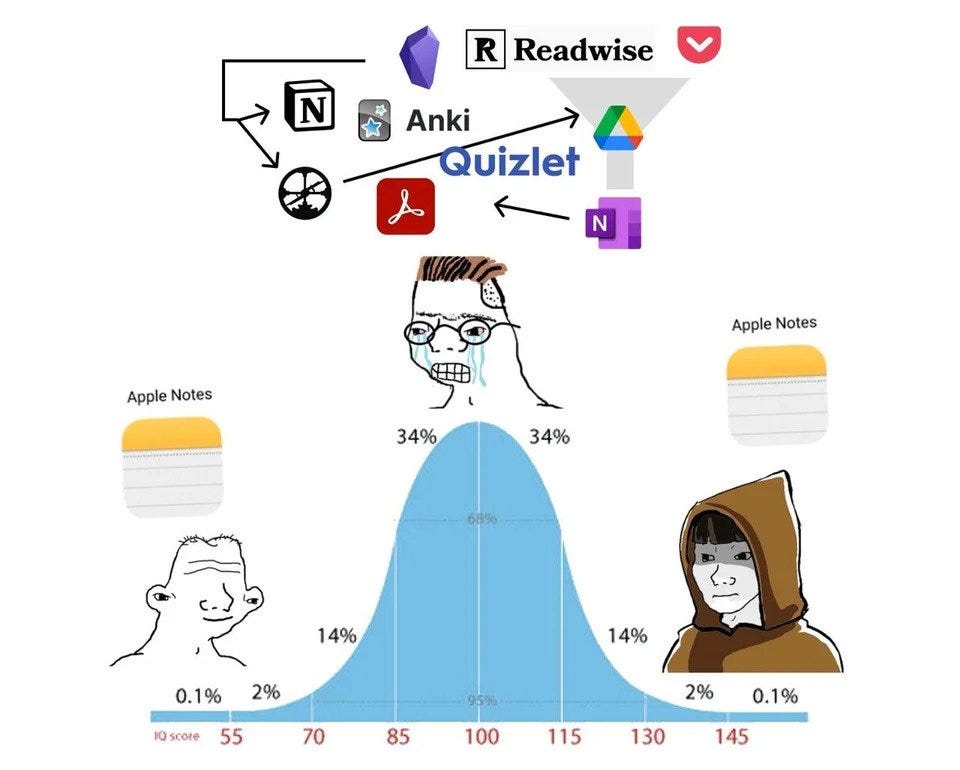
I have conceded — after literal years of experimenting with different systems and apps — that Apple Notes is good enough for me.
Good enough, but not perfect. It has frustrating limitations — deal-breakers for some (e.g., data portability remains low) — and it’s behind the modern-day note-taking app trends (no backlinks!)
But for taking notes from reading material, the most annoying of all is the lack of block quote styling. A small paper cut that I had felt multiple times a day everyday.
That is, until I realized (/learned) that copy-pasting, or even typing, quotes into your notes is not the way to go. For best information retention and quality selection, you should write down quotes in longhand.
Handwriting takes more effort. Even more so these days, when pretty much every piece of text I write is typed on the keyboard. My hand has forgotten how to hold a pen and guide it on paper. It doesn’t help that my handwriting has always been like chicken scratch.
All this is to say that it takes extra effort. And I don’t want to waste that on things/quotes/words that are not worth it. This naturally leads to a more exacting selection of what quotes I want to save. This is the last test that any piece of writing needs to pass before it ends in my book note.
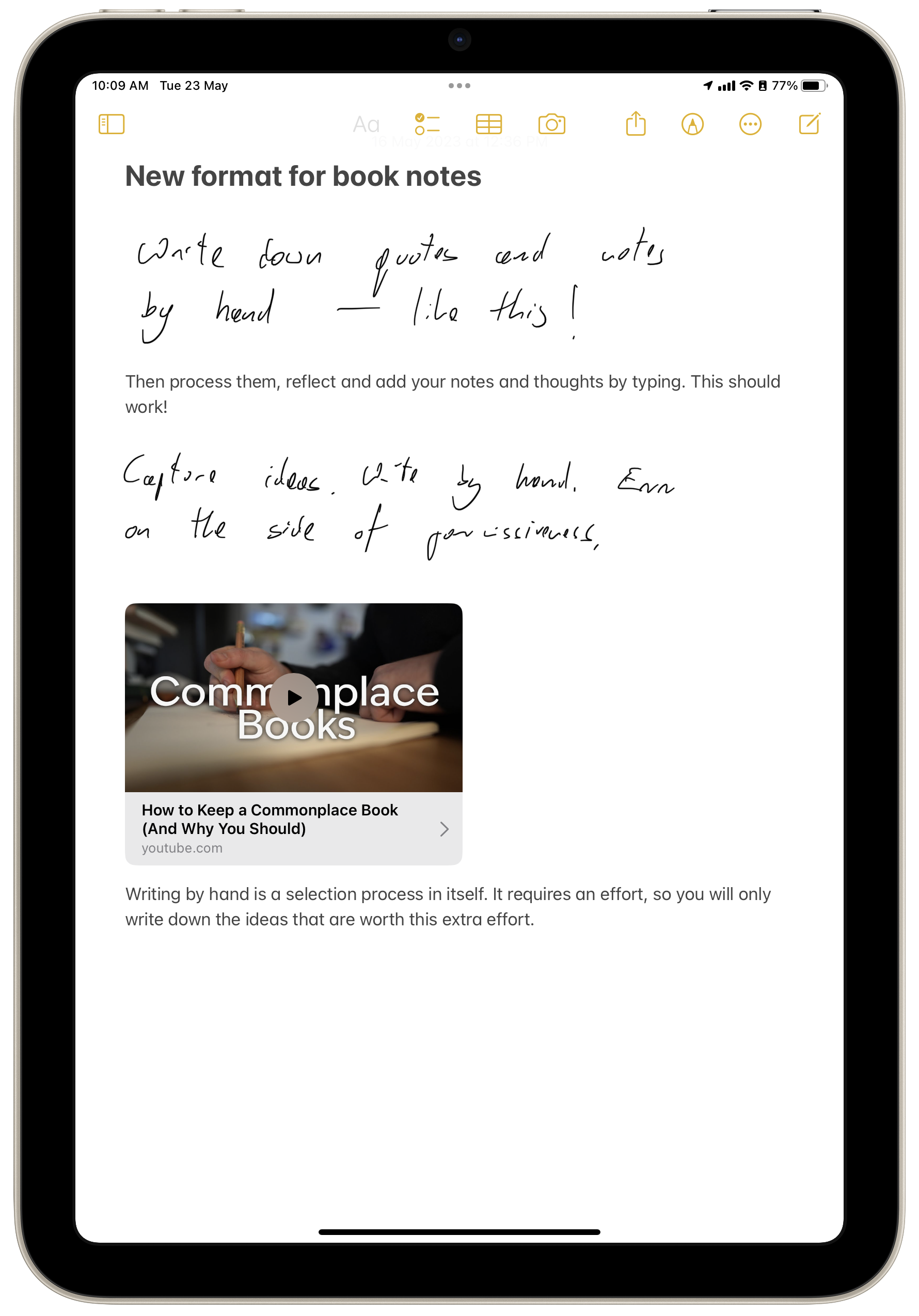
There are a couple of steps before that, though. When I read a book, it’s usually on my iPad mini and I always have my Apple Pencil nearby — ready for it’s highlighting duty.
When I highlight paragraphs and passages I err on the side of permissiveness. Anything that looks interesting to me will end up in yellow. Whole paragraphs, bulleted lists, ideas, or thought provoking one-liners.
And then I let them wait. Want to get some distance between the material I’ve just read and my own thoughts. Let them incubate, take shape.
Time will do a few things to those excerpts. Some will seem less profound upon second review. Others will gain new meaning after I’m done with the whole book. Some are good, but the timing is off — maybe, when I come back to this book at some time in the future, I will find more value there. And there will be a few special ones that will lead to brand new ideas after I ruminate on them for a while.
I take all that, open my Kindle app again, and start going through the highlights one by one. Everything that passes the selection process goes into Apple Notes (I stick to one note per book/source; not splitting each quote/insight into its own atomic note) — and it’s all in longhand.
That’s how this frustrating Apple Notes limitation (no blockquotes) led me into something that’s conducive to better selection, better information retention, while remaining visually distinct form everything else.
Processing the books I read doesn’t stop there.
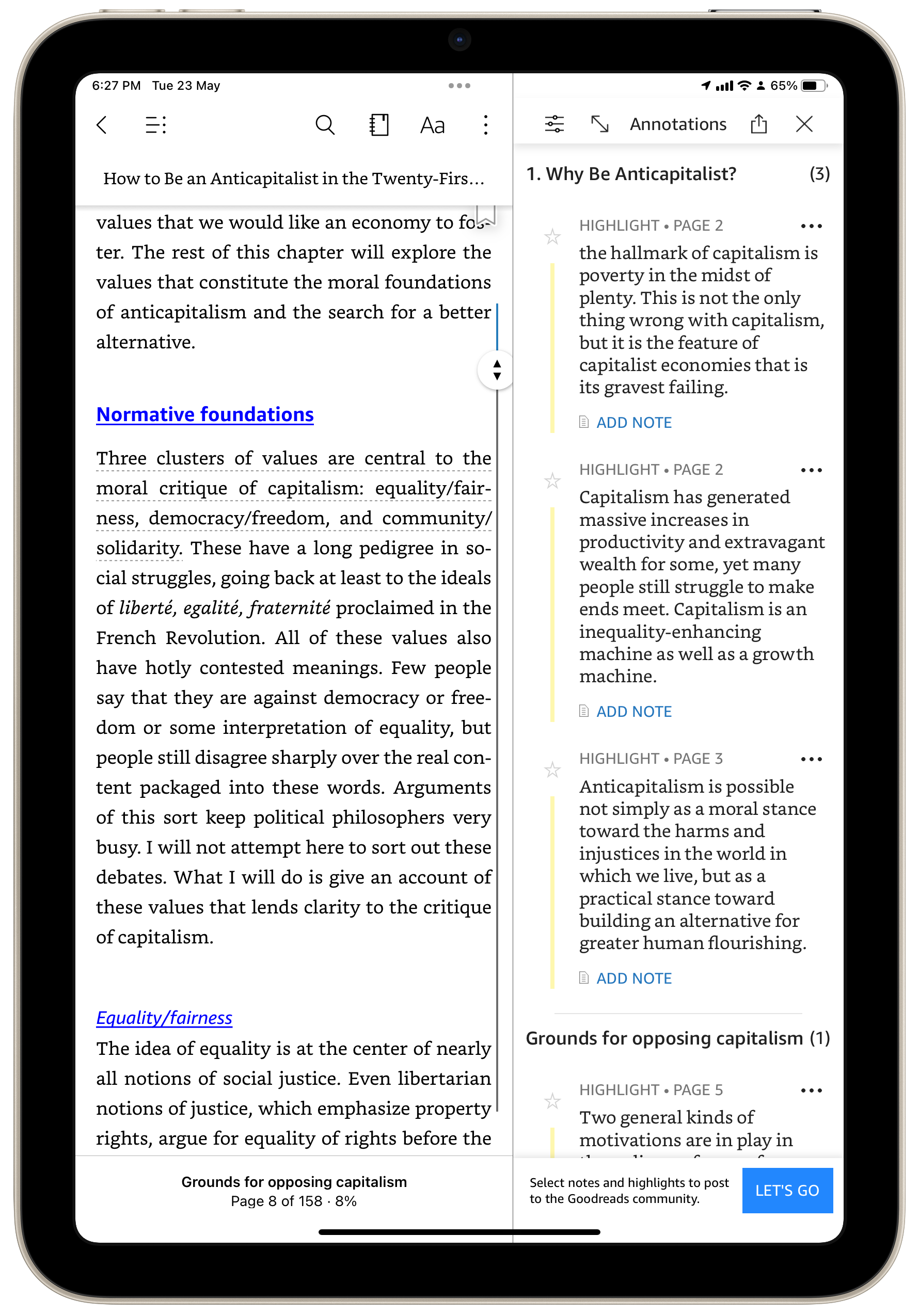
Simply rewriting paragraphs of a book into my notes isn’t what I’m looking for. My notebook is not just a memorization or information storage tool. It’s a thinking tool. And for me, thinking through writing works best.
Underneath each handwritten quote, there’s room for my own reflection. I write down (at this point, typing is okay — I want this part to be searchable, legible, visually distinct from the quotes themselves, and easy to transfer somewhere else — like this newsletter). I type my own understanding of what I read, how it relates to my own circumstances, and how it fits into my existing habits, skills, mental models, knowledge base, and whatnot. I try to explain what I read and highlighted to myself — and in my own words.
This part has to stand on its own. If I go back to this note in a few years from now, I should still be able to understand it easily — without any additional context or instruction.
The in my own words part is critical. It’s a test for my own understanding of the material. Can I explain it in my own words? If I can’t, that means there’s something I missed and — likely — additional reading (and/or thinking) I need to do. (See: Feynman Technique.)
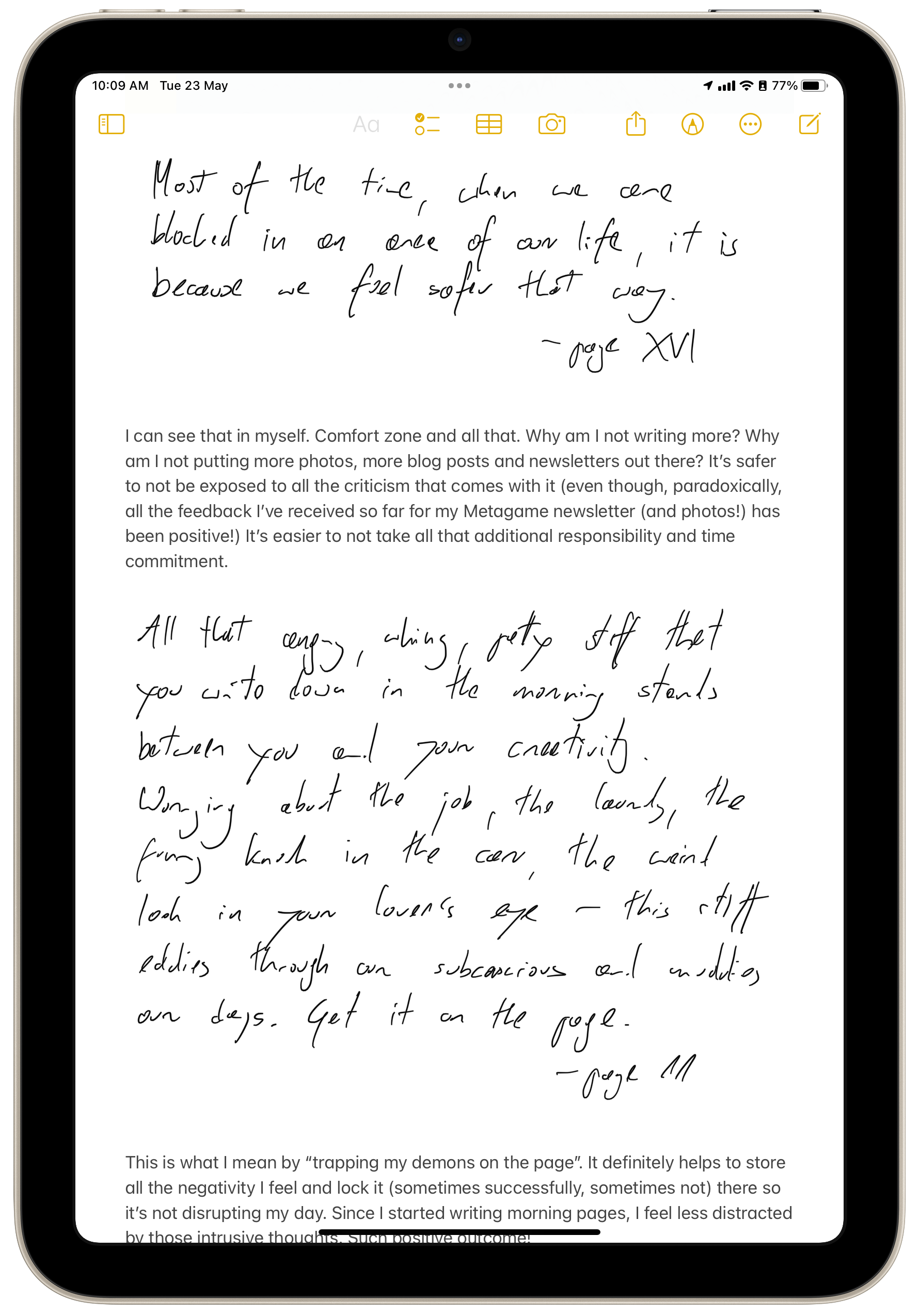
This typically leads to ~1–3 paragraphs of additional typed text underneath each quote. That means that some particularly insightful, though-provoking, and information-dense books leave me with a really long note and a large body of text. Therefore, in the next step I need to distill my own thoughts into the most important/profound findings. This is where progressive summarization comes to play — and, thankfully, Apple Notes’ formatting options are sufficient for that purpose:
- All notes start with regular body text.
- Important things I then make stand out with the bold style.
- And thought’s that are particularly profound, ones that I’m sure I will get back to later (e.g., to use in an article I write, or things that prompt me to write a separate evergreen note) get bold and underline style so they stand out the most.
I wish Apple Notes allowed to highlight typed text (ideally with the Pencil, but even a regular highlight would be a big win), but for now this is the best I’ve got.
To summarize, my reading/note-taking process now includes:
- Reading a book and being ready to highlight the interesting bits.
- Letting highlights rest for a while.
- Selecting quotes that are worth writing down by hand.
- Reflecting and adding my own thoughts.
- Letting those sit for a bit as well.
- Selecting the best stuff again — but this time from among my own thoughts.
It’s an enjoyable process for me and I particularly like how it leaves me with a proper proof that I’ve read something valuable, understood it, and extracted useful insights out of it.
This is what works for me right now. For taking notes from books, articles, YouTube videos, podcasts, audiobooks, whathaveyou. It may or may not work for you. (Give it a try, maybe?) It may or may not work for me in the future (I really need to stop switching note-taking systems and apps and let myself use one for a longer period).
It's nothing revolutionary — just making use of what I already have access to. Should do this more often.
— Chris


Member discussion